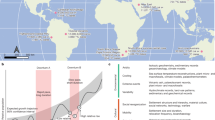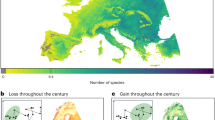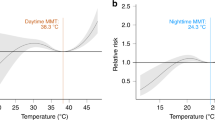Abstract
Protected area (PA) performance is thought to depend on effective conservation management and favourable socio-economic context. However, increasing evidence of continued biodiversity decline within PAs raises the question of whether fundamental ecological and socio-economic constraints might actually affect PA effectiveness. Here we quantify how threats to biodiversity, socio-economic context and conservation efforts play out across 114 PAs in 25 European and African countries. We found that even in the presence of highly favourable socio-economic context and conservation efforts, it is not possible to completely offset the intensity of threats and prevent biodiversity decline. Projections show that halting biodiversity decline across the studied PA network may require at least a 35% increase in conservation efforts over a decade. However, as PAs approach zero biodiversity loss, even greater efforts and resources would be needed because of the principle of diminishing marginal returns. Our findings point to limited effectiveness of PAs and their management that might not be possible to address by simply increasing resources. Additionally, the adoption of core design principles of sustainable systems that take into account the social–ecological contexts of PAs could help overcome the observed hurdles of limited effectiveness and thus better integrate PAs into sustainable development efforts.
This is a preview of subscription content, access via your institution
Access options
Access Nature and 54 other Nature Portfolio journals
Get Nature+, our best-value online-access subscription
$29.99 / 30 days
cancel any time
Subscribe to this journal
Receive 12 digital issues and online access to articles
$119.00 per year
only $9.92 per issue
Buy this article
- Purchase on Springer Link
- Instant access to full article PDF
Prices may be subject to local taxes which are calculated during checkout




Similar content being viewed by others
Data availability
The full datasets generated as part of this study are not publicly available due to sensitivity and confidentiality of information but are available from the corresponding authors on reasonable request. However, the minimum datasets required for replicating and interpreting this study are available in the Supplementary Information.
Code availability
The R code used for data analyses in this study is available as supplementary information.
References
Tittensor, D. P. et al. A mid-term analysis of progress toward international biodiversity targets. Science 346, 241–243 (2014).
IPBES Secretariat Summary for Policymakers of the Global Assessment Report on Biodiversity and Ecosystem Services of the Intergovernmental Science—Policy Platform on Biodiversity and Ecosystem Services (IPBES, 2019).
Bruner, A. G., Gullison, R. E., Rice, R. E. & Fonseca, G. A. Bda Effectiveness of parks in protecting tropical biodiversity. Science 291, 125–128 (2001).
Geldmann, J., Joppa, L. N. & Burgess, N. D. Mapping change in human pressure globally on land and within protected areas. Conserv. Biol. 28, 1604–1616 (2014).
Laurance, W. F. et al. Averting biodiversity collapse in tropical forest protected areas. Nature 489, 290–293 (2012).
Conference of the Parties, The Strategic Plan for Biodiversity 2011–2020 and the Aichi Biodiversity Targets, COP-10 Decision X/2 (CBD, 2010).
Protected Planet Report 2018 (UNEP-WCMC IUCN & NGS, 2018).
Craigie, I. D. et al. Large mammal population declines in Africa’s protected areas. Biol. Conserv. 143, 2221–2228 (2010).
Joppa, L. N., Bailie, J. E. M. & Robinson, J. G. Protected Areas: Are They Safeguarding Biodiversity?. (Wiley Blackwell, 2016).
Rada, S. et al. Protected areas do not mitigate biodiversity declines: a case study on butterflies. Divers. Distrib. 25, 217–224 (2019).
Jetz, W., McPherson, J. M. & Guralnick, R. P. Integrating biodiversity distribution knowledge: toward a global map of life. Trends Ecol. Evol. 27, 151–159 (2012).
Geldmann, J. et al. Effectiveness of terrestrial protected areas in reducing habitat loss and population declines. Biol. Conserv. 161, 230–238 (2013).
Kindsvater, H. K. et al. Overcoming the data crisis in biodiversity conservation. Trends Ecol. Evol. 33, 676–688 (2018).
Sutherland, W. J., Pullin, A. S., Dolman, P. M. & Knight, T. M. The need for evidence-based conservation. Trends Ecol. Evol. 19, 305–308 (2004).
Ferraro, P. J. & Pattanayak, S. K. Money for nothing? A call for empirical evaluation of biodiversity conservation investments. PLoS Biol. 4, 482–488 (2006).
Polaina, E., González-Suárez, M. & Revilla, E. Socioeconomic correlates of global mammalian conservation status. Ecosphere 6, 1–34. (2015).
Ferraro, P. J. & Pressey, R. L. Measuring the difference made by conservation initiatives: protected areas and their environmental and social impacts. Philos. Trans. R. Soc. Lond. Biol. Sci. 370, 20140270 (2015).
Geldmann, J., Manica, A., Burgess, N. D., Coad, L. & Balmford, A. A global-level assessment of the effectiveness of protected areas at resisting anthropogenic pressures. Proc. Natl Acad. Sci. U.S.A. 116, 23209–23215 (2019).
McGinnis, M. D. & Ostrom, E. Social-ecological system framework: initial changes and continuing challenges. Ecol. Soc. 19, 30 (2014).
Barnes, M. D. et al. Wildlife population trends in protected areas predicted by national socio-economic metrics and body size. Nat. Commun. 7, 12747 (2016).
Palomo, I. et al. Incorporating the social-ecological approach in protected areas in the anthropocene. BioScience 64, 181–191 (2014).
Poteete, A. R., Janssen, M. A., & Ostrom, E. Working Together: Collective Action, the Commons, and Multiple Methods in Practice (Princeton Univ. Press, 2010).
Wilson, D. S., Ostrom, E. & Cox, M. E. Generalizing the core design principles for the efficacy of groups. J. Econ. Behav. Organ. 90, S21–S32 (2013).
Tebet, G., Trimble, M. & Pereira Medeiros, R. Using Ostrom’s principles to assess institutional dynamics of conservation: lessons from a marine protected area in Brazil. Mar. Policy 88, 174–181 (2018).
Ban, N. C. et al. Social and ecological effectiveness of large marine protected areas. Glob. Environ. Change 43, 82–91 (2017).
Fleischman, F. D. et al. Governing large-scale social-ecological systems: lessons from five cases. Int. J. Commons 8, 428–456 (2014).
Faff, R., Ho, Y. K., Lin, W. & Yap, C. M. Diminishing marginal returns from R&D investment: evidence from manufacturing firms. Appl. Econ. 45, 611–622 (2013).
Gill, D. A. et al. Capacity shortfalls hinder the performance of marine protected areas globally. Nature 543, 665–669 (2017).
Bowles, S. & Polanía-Reyes, S. Economic incentives and social preferences: substitutes or complements? J. Econ. Lit. 50, 368–425 (2012).
Irwin, K., Mulder, L. & Simpson, B. The detrimental effects of sanctions on intragroup trust: comparing punishments and rewards. Soc. Psychol. Q. 77, 253–272 (2014).
Pacifici, M. et al. Assessing species vulnerability to climate change. Nat. Clim. Change 5, 215–225. (2015).
Urban, M. Accelerating extinction risk from climate change. Science 348, 571–573 (2015).
Lovett, G. M. et al. Effects of air pollution on ecosystems and biological diversity in the eastern United States. Ann. N. Y. Acad. Sci. 1162, 99–135 (2009).
Backhaus, T., Snape, J. & Lazorchak, J. The impact of chemical pollution on biodiversity and ecosystem services: the need for an improved understanding. Integr. Environ. Assess. Manag. 8, 575–576 (2012).
Benítez-López, A. et al. The impact of hunting on tropical mammal and bird populations. Science 356, 180–183 (2017).
Calabrese, A. et al. Conservation status of Asian elephants: the influence of habitat and governance. Biodivers. Conserv. 26, 2067–2081 (2017).
Shaffer, L. J., Khadka, K. K., Van Den Hoek, J. & Naithani, K. J. Human–elephant conflict: a review of current management strategies and future directions. Front. Ecol. Evol. 6, 235 (2019).
Klaassen, R. H. G. et al. When and where does mortality occur in migratory birds? Direct evidence from long-term satellite tracking of raptors. J. Anim. Ecol. 83, 176–184 (2014).
Güneralp, P. & Seto, K. C. Futures of global urban expansion: uncertainties and implications for biodiversity conservation. Environ. Res. Lett. 8, 014025 (2013).
Sherry, T.W., Johnson, M.D. & Strong, A. in Birds of Two Worlds. The Ecology and Evolution of Migration (eds Greenberg, R. & Marra, P. P.) 414–425 (The John Hopkins Univ. Press, 2005).
Sanderson, F. J., Donald, P. F., Pain, D. J., Burfield, I. J. & Van Bommel, F. P. Long-term population declines in Afro-Palearctic migrant birds. Biol. Conserv. 131, 93–105 (2006).
Runge, C. A. et al. Protected areas and global conservation of migratory birds. Science 350, 1255–1258 (2015).
Balme, G. A., Slotow, R. & Hunter, L. T. B. Edge effects and the impact of non-protected areas in carnivore conservation: leopards in the Phinda-Mkhuze Complex, South Africa. Anim. Conserv. 13, 315–323 (2010).
Chase, J. M., Blowes, S. A., Knight, T. M., Gerstner, K. & May, F. Ecosystem decay exacerbates biodiversity loss with habitat loss. Nature 584, 238–243 (2020).
Ostrom, E. Governing the Commons: The Evolution of Institutions for Collective Action (Cambridge Univ. Press, 1990).
Lacroix, K. & Richards, G. An alternative policy evaluation of the British Columbia carbon tax: broadening the application of Elinor Ostrom’s design principles for managing common-pool resources. Ecol. Soc. 20, 38 (2015).
Bennett, N. J. et al. Mainstreaming the social sciences in conservation. Conserv. Biol. 31, 56–66 (2017).
Dasgupta, P. The Economics of Biodiversity: The Dasgupta Review (HM Treasury, 2021).
Resasco, J. Meta-analysis on a decade of testing corridor efficacy: what new have we learned? Curr. Landsc. Ecol. Rep. 4, 61–69 (2019).
Andrade, G. S. M. & Rhodes, J. R. Protected areas and local communities: an inevitable partnership toward successful conservation strategies? Ecol. Soc. https://doi.org/10.5751/ES-05216-170414 (2012).
Morell, V. Massive wolf kill disrupts long-running Yellowstone Park study. Science 375, 482–482 (2022).
Post, G. & Geldmann, J. Exceptional responders in conservation. Conserv. Biol. 32, 576–583 (2018).
Wauchope, H. S. et al. Protected areas have a mixed impact on waterbirds, but management helps. Nature 605, 103–107 (2022).
Ostrom, E. A general framework for analyzing sustainability of social–ecological systems. Science 325, 419–422 (2009).
Kline, M. A., Waring, T. M. & Salerno, J. D. Designing cultural multilevel selection research for sustainability science. Sustainability Sci. 13, 9–19 (2017).
Lindsey, P. A. et al. The performance of African protected areas for lions and their prey. Biol. Conserv. 209, 137–149 (2017).
The World Database on Protected Areas (WDPA) (IUCN & UNEP‐WCMC, 2018); https://www.protectedplanet.net/en/search-areas?geo_type=country&filters%5Bdb_type%5D%5B%5D=wdpa
Coad, L. et al. Measuring impact of protected area management interventions: current and future use of the global database of protected area management effectiveness. Phil. Trans. R. Soc. B 370, 20140281 (2015).
Geldmann, J. et al. A global analysis of management capacity and ecological outcomes in terrestrial protected areas. Conserv. Lett. 11, e12434 (2018).
Living Planet Database (LPD) (Zoological Society of London, 2018); http://www.livingplanetindex.org
Kühl, H., Williamson, L., Sanz, C. M., Morgan, D. & Boesch, C. Launch of A.P.E.S. database. Gorilla Journal 34, 20–21 (2007).
Koerner, S. E., Poulsen, J. R., Blanchard, E. J., Okouyi, J. & Clark, C. J. Vertebrate community composition and diversity declines along a defaunation gradient radiating from rural villages in Gabon. J. Appl. Ecol. 54, 805–814 (2017).
Bauer, H. et al. Lion (Panthera leo) populations are declining rapidly across Africa, except in intensively managed areas. Proc. Natl Acad. Sci. U.S.A. 112, 14894–14899 (2015).
Barr, D., Levy, R., Scheepers, C. & Tily, H. J. Random effects structure for confirmatory hypothesis testing: keep it maximal. J. Mem. Lang. 68, 1–43 (2014).
Schielzeth, H. & Forstmeier, W. Conclusions beyond support: overconfident estimates in mixed models. Behav. Ecol. 20, 416–420 (2009).
McElreath, R. in Statistical Rethinking: A Bayesian Course with Examples in R and Stan (CRC Press, 2016).
Bürkner, P. C. (2017). brms: an R package for Bayesian multilevel models using Stan. J. Stat. Software https://doi.org/10.18637/jss.v080.i01 (2017).
Schielzeth, H. Simple means to improve the interpretability of regression coefficients. Methods Ecol. Evol. 1, 103–113 (2010).
R Core Team R: A language and environment for statistical computing (R Foundation for Statistical Computing, 2019).
Gelman, A., Carlin, J. B. B., Stern, H. S. S. & Rubin, D. B. B. Bayesian Data Analysis (CRC Press, 2014).
Protected Planet: The World Database on Protected Areas (WDPA) (UNEP-WCMC & IUCN, 2019); www.protectedplanet.net
Chamberlain, S. rphylopic: Get ‘Silhouettes’ of ‘Organisms’ from ‘Phylopic’. R version 0.3.3.91 https://github.com/sckott/rphylopic (2022).
Acknowledgements
Our gratitude goes to all PA managers who participated in our survey and filled in our questionnaire (full list of PAs is given in Supplementary Information). We are also grateful to those who participated in the non-governmental organization survey and filled in our questionnaire: Z. Záborská (Regional Tourism Organization Slovenský raj & Spiš), K. Kaliský (Arolla Film), Lesoochranárske zoskupenie VLK (a WOLF Forest Protection Movement), V. Bartuš (WOLF Forest Protection Movement, Eastern Carpathians tribe), Hnutí DUHA Olomouc (an environmental movement in Czech Republic), T.P. Kneževi (World Wildlife Fund Poland, IUCN World Commission on Protected Areas), New Horizons Foundation (Romania), O. Ionescu (Transylvania University), F. Stoican (Asociatia Kogayon), A. Szabo (Asociatia Euroland Banat), Asociatia Salvati flora si fauna Deltei Dunarii, Propark-Fundatia pentru Arii Protejate, J. Kouassi, Y. Kablan, E. Danquah (Department of Wildlife and Range Management, Faculty of Renewable Natural Resources, Kwame Nkrumah University of Science and Technology, Kumasi, Ghana), A. Samuel and the Conservation Through Public Health Conservation Through Public Health. We also would like to thank A. Bohdan, S. Bunel, H. Chamkhi, M. Duskova, V. Kandza, E. Mbaygone, N. Moses, T.F. Neba, I.O. Németh, P. Sabo, C. Tweh, A. Vaidos, M. Wambui and others for their support in collecting the data. We gratefully acknowledge the financial support obtained for the study from the German Center for Integrative Biodiversity Research (iDiv) (DFG FZT 118, 202548816; T.T.G. and H.S.K.) and the Robert Bosch Foundation (grant number 32.5.8043.0016.0; H.S.K.).
Author information
Authors and Affiliations
Contributions
All authors equally contributed to the paper. T.T.G., L.K., M.B., A.B., L.B., D.E., A.F., S.H., M.H., K.W., M.W., T.S. and H.S.K. conceptualized the study and carried out initial planning. L.K. carried out the statistical analysis and was supported by T.T.G. and H.S.K. The first draft was prepared by T.T.G. and H.S.K., which was revised by L.K., M.B., A.B., L.B., D.E., A.F., S.H., M.H., K.W., M.W. and T.S. All authors reviewed and contributed to a final draft and revised versions and approved the final version for publication.
Corresponding authors
Ethics declarations
Competing interests
The authors declare no competing interests.
Peer review
Peer review information
Nature Sustainability thanks Donald DeAngelis, Stephen Woodley and the other, anonymous, reviewer(s) for their contribution to the peer review of this work.
Additional information
Publisher’s note Springer Nature remains neutral with regard to jurisdictional claims in published maps and institutional affiliations.
Supplementary information
Supplementary Information
Supplementary Figs. 1–9 and Tables 1–8.
Supplementary Data 1
This file contains all the data used for running the different models of this study.
Supplementary Software 1
This file contains the R script for data analyses of this study.
Supplementary Software 2
This file contains the R image for this study.
Supplementary Note 1
This file contains the questionnaire used for the study in Africa.
Supplementary Note 2
This file contains the questionnaire used for the study in Europe.
Rights and permissions
About this article
Cite this article
Gatiso, T.T., Kulik, L., Bachmann, M. et al. Effectiveness of protected areas influenced by socio-economic context. Nat Sustain 5, 861–868 (2022). https://doi.org/10.1038/s41893-022-00932-6
Received:
Accepted:
Published:
Issue Date:
DOI: https://doi.org/10.1038/s41893-022-00932-6
This article is cited by
-
The geometry of global protected lands
Nature Sustainability (2023)



